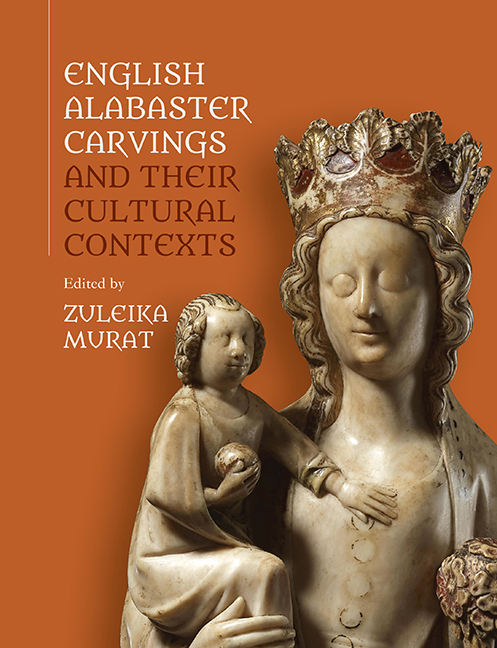Book contents
- Frontmatter
- CONTENTS
- List of Illustrations
- Acknowledgements
- List of Contributors
- Introduction
- 1 ‘Burton-Upon-Trent, Not Nottingham.’ the Evolving Study Of Medieval English Alabaster Sculpture
- 2 Stone to Ensure Victory and to Generate Friendships. On The Meaning of Alabaster
- 3 Contextualising English Alabasters in the Material Culture of the Medieval Mediterranean
- 4 English Alabaster Images As Recipients of Music in the Long Fifteenth Century: English Sacred Traditions in a European Perspective
- 5 Contextualising Alabasters in Their Immersive Environment. The ‘Ancona D'Allabastro Di Diverse Figure’ of the Novalesa Abbey: Meaning and Function
- 6 Alabaster Carvings in Late-Medieval Lincolnshire
- 7 ‘Tabernacles, Howsynges and Other Things’. Three Alabasters From the Burrell Collection in Context
- 8 Conservation Study of Three Alabaster Carvings From the Burrell Collection, Glasgow Museums
- 9 ‘Smooth as Monumental Alabaster’. the Alabaster Tomb Industry in England 1550–1660
- 10 Merchants’ Tombs in Alabaster
- 11 Exploring Alice: the Theological, Socio-Historical, and Anatomical Context of the De La Pole Cadaver Sculpture
- Bibliography
- Index
- Already Published
3 - Contextualising English Alabasters in the Material Culture of the Medieval Mediterranean
Published online by Cambridge University Press: 14 September 2019
- Frontmatter
- CONTENTS
- List of Illustrations
- Acknowledgements
- List of Contributors
- Introduction
- 1 ‘Burton-Upon-Trent, Not Nottingham.’ the Evolving Study Of Medieval English Alabaster Sculpture
- 2 Stone to Ensure Victory and to Generate Friendships. On The Meaning of Alabaster
- 3 Contextualising English Alabasters in the Material Culture of the Medieval Mediterranean
- 4 English Alabaster Images As Recipients of Music in the Long Fifteenth Century: English Sacred Traditions in a European Perspective
- 5 Contextualising Alabasters in Their Immersive Environment. The ‘Ancona D'Allabastro Di Diverse Figure’ of the Novalesa Abbey: Meaning and Function
- 6 Alabaster Carvings in Late-Medieval Lincolnshire
- 7 ‘Tabernacles, Howsynges and Other Things’. Three Alabasters From the Burrell Collection in Context
- 8 Conservation Study of Three Alabaster Carvings From the Burrell Collection, Glasgow Museums
- 9 ‘Smooth as Monumental Alabaster’. the Alabaster Tomb Industry in England 1550–1660
- 10 Merchants’ Tombs in Alabaster
- 11 Exploring Alice: the Theological, Socio-Historical, and Anatomical Context of the De La Pole Cadaver Sculpture
- Bibliography
- Index
- Already Published
Summary
London, 4 May 1382. King Richard II orders that the papal collector Cosmato Gentilis be granted permission to export clothes, garments, and a pewter plate, as well as large alabaster figures of the Virgin Mary, saints Peter and Paul, and the Trinity, to Rome. Two superb alabaster images of the Princes of the Apostles (Pl. IV) preserved in the Roman church of Santa Croce in Gerusalemme have been identified as the only items to survive from this cargo of luxury English goods shipped to Italy.
People throughout the late Middle Ages and the Early Modern era were fascinated by high-end objects produced in England because of their design, style and skilful craftmanship, as well as their precious and colourful materials. Popes, high prelates, and wealthy rulers on the continent sought them perhaps too avidly, as implied by a malevolent Matthew Paris when he credited the Genoese pope Innocent IV (reigned 1243–54) with the famous utterance: ‘Truly, England is our garden of delights, an inexhaustible well from whose plenty many things may be extorted’. Sinibaldo Fieschi was referring to the richly textured and vividly coloured and illustrated copes and chasubles worn by English cardinals and bishops; objects in which he himself is known to have delighted. English embroidery had already long been met with appreciation across the continent where it came to be known as opus anglicanum to identify it with its place of manufacture. Soon after their emergence in the fourteenth century English alabaster carvings became prized by wealthy patrons, quickly surpassing other alabaster products from across Europe.
This essay contextualises the diffusion of medieval English alabasters as part of a broader contemporary fascination with highly polished objects carved in white, light-reflecting and light-diffusing media in Europe and the Medieval Mediterranean. I will begin by exploring what materials were identified as alabaster by medieval viewers and the physical properties with which it was credited. I will then investigate how these same observers approached objects crafted in marble, ivory and bone. In so doing, I aim to recover both the workshop jargon and the literary vocabulary used by people in the Middle Ages to talk and write about the materiality and aesthetics of sculptural surfaces.
- Type
- Chapter
- Information
- English Alabaster Carvings and their Cultural Contexts , pp. 71 - 92Publisher: Boydell & BrewerPrint publication year: 2019

